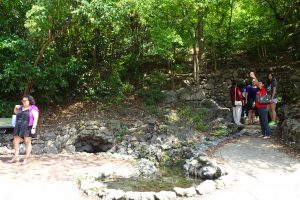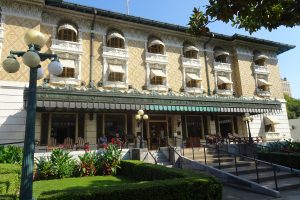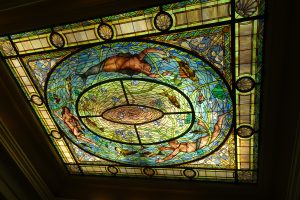5 Oct: We usually think of woods, mountains, canyons, and such nature settings for National Parks, but Hot Springs NP gave us a different and yet interesting experience. Rain water at Hot Springs, Arkansas, seeps more than a mile deep through porous sedimentary rock, heats up by 4 degrees every 300 feet it descends, then travels up through cracks it encounters in a fault zone to emerge in a cluster of springs about 4,000 years later. Native Americans enjoyed soaking in water from these hot springs at least as early as the 1700s. In response to rapid growth of tourism and commercialism after American settlers had moved into the area, the Federal government took control of the land immediately surrounding the springs in 1832 to safeguard this natural resource by managing its distribution, protecting it from pollution, prohibiting unsightly uses, and monitoring the water quality. This makes the park significant as the oldest unit by far in what is now the National Park system, although it was named Hot Springs Reservation and not given National Park status until 1921. It is also unusual among our National Parks because it’s in the middle of a city. Bathhouse row is within the National Park boundary, and the National Park is within the city of Hot Springs.

The government leases building lots to commercial enterprises, which build bathhouses. At first these were crude canvas and wooden structures, but they were later replaced by buildings with more luxurious buildings to compete for customers. Following a couple of major fires in the city, bathhouses were required to be built of non-combustible materials after about 1910. The popularity of bathing in the reputedly healthful spring waters increased rapidly. Early on, it was considered primarily to be for medical treatment, available primarily by prescription. Later, it became more and more of a luxury vacation experience. Bathhouse businesses flourished in the 1920s and 1930s, and attained their peak in 1946. Today there are eight of the grand old bathhouse buildings remaining, and only two of those still provide baths. The famously luxurious Fordyce Bathhouse now houses the National Park’s visitor center and rangers conduct tours of the facilities inside it. The hillside behind bathhouse row was developed into a beautifully landscaped park, with a wide brick-paved boulevard and several trails for walking and exercising. Several major league baseball teams have used Hot Springs for spring training over the years. For less well-heeled visitors, the government has provided at various times a free bathhouse in a less opulent and more communal type of facility. A government medical facility for veterans was built in the 1890s behind bathhouse row.

